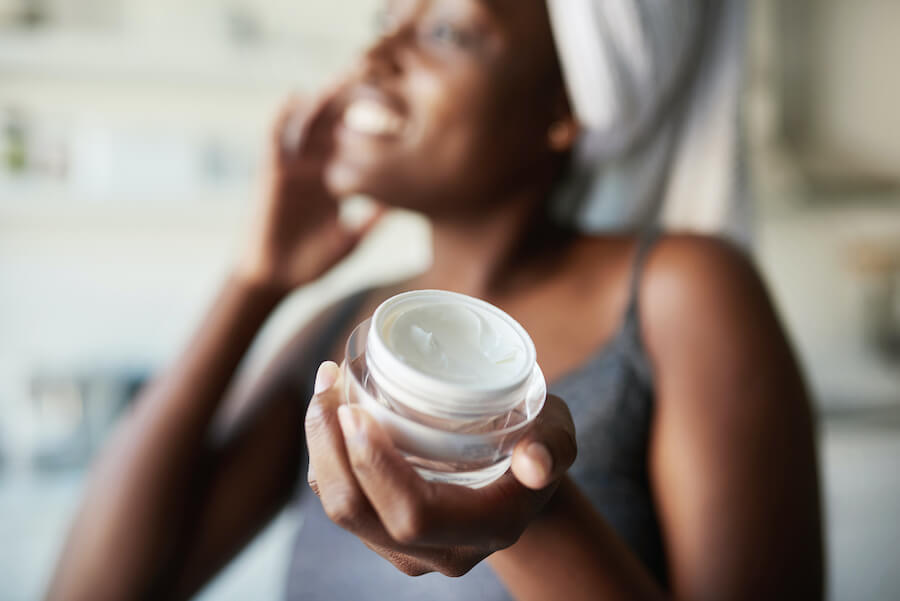What is hydroquinone used for?
Hydroquinone is a skin-lightening agent. It lightens the skin, which is beneficial for treating many types of hyperpigmentation. It temporarily prevents your body from producing the pigment known as melanin, which gives your skin its color.
To brighten regions of darker skin like freckles, age spots, melasma (sun damage), or chloasma caused by pregnancy, birth control pills, hormone medicine, or injury to the skin, apply hydroquinone topical.
Hydroquinone is available in cream, gel, lotion, and emulsion form. Although it is safe to use some may experience side effects.
It is used to treat dyschromia- melasma, solar lentigines, freckles, post-inflammatory hyperpigmentation, chloasma.
Patients with melasma and post-inflammatory hyperpigmentation are the ones who utilize it the most regularly.

Post-inflammatory hyperpigmentation :- Skin inflammation leads to an increase in melanin production, which leads to postinflammatory hyperpigmentation. Acne vulgaris, eczematous dermatoses, contact dermatitis, psoriasis, lichen planus, and burns are the causes of post-inflammatory hyperpigmentation. The most frequent cause of hyperpigmentation is photodamage from exposure. It is used to treat postinflammatory hyperpigmentation and photoprotection. With hydroquinone, improvements take many weeks to months to appear.
Melasma :- Melasma is an acquired hyperpigmentation disorder that often affects the forehead, cheeks, and chin on the face. It appears as pigmented macules and patches that are evenly spaced. The pathogenesis of melasma is influenced by darker skin, UV light, hormones, genetics, and antiepileptic drugs. Because the expression of estrogen receptors appears to increase in melasma lesions as well, patients who are pregnant or use oral contraceptives are at risk. Melanocyte-stimulating hormone (MSH), which is released by estrogen, then stimulates tyrosinase, increasing the formation of melanin. That’s why melasma is more common in females than males.
Freckles :- Darker dots or patches known as freckles typically appear on fair skin. When exposed to sunlight, they could become more visible.
Lentigines :- On areas of skin that have received the most sun exposure, lentigos, also known as age spots, form such as the face and backs of the hands. They typically range in breadth from 0.2 cm to 2 cm and are flat, and dark.
Acne scars :- Acne can develop when germs, dead skin cells, and excess oil block skin pores. The body tries to heal the wounds, but sometimes scars remain.
Compounded drugs achieve the desired outcome with a reduced risk of side effects. If you need a compounded medication, call AllayMeds.
Uses of hydroquinone :- To lighten dark spots on the skin.
Dosages of hydroquinone :-
- Topical cream - 2%, 4%
- Lotion - 2%
- Emulsion - 4%
- Topical solution - 2%, 3%
- Topical Gel - 2%, 4%
How to use it?
Follow all usage instructions provided on the product's packaging or follow your doctor's advice. Do a patch test on the hand and within 24 hours, monitor the area for any severe adverse effects. Contact your doctor if the test area is red or puffy. You can start the treatment if there is only minor redness.
Apply hydroquinone twice a day or as directed by your doctor. Only the skin may be treated with this medicine. Unwanted skin lightening may occur if it is not used correctly. The skin's treated areas may become more sun-sensitive as a result of this medicine. To get the greatest benefits from this drug, take it frequently.
Unless you are using this medication to treat the skin on your hands, wash your hands both before and after using it. Only the damaged skin areas that require whitening should receive this medication. Avoid applying any medication to the skin near these locations.
Keep your products at room temperature away from heat and moisture.
If your condition worsens or if your symptoms do not go away after two months, call your doctor.
How does it work?
Hydroquinone reduces the number of melanocytes present, which makes melanin, which is what gives your skin tone. More melanin is present when hyperpigmentation is prevalent. Your skin will gradually balance out in tone if you manage these melanocytes.
The average time it takes for the component to start working is four weeks.
Side Effects of hydroquinone :-
- Mild skin irritation
- Dryness
- Redness
- Inflammation
- Itching
- Dermatitis or allergic reactions

People should use the product carefully on their faces and avoid getting it in their eyes.
Ask your doctor or pharmacist if it is okay for you to use this medication if you have ever had: liver or kidney disease, asthma, or if you are using antibiotic medicine. If you are expecting or nursing a baby, talk to your doctor before using this medicine.
What to avoid while using hydroquinone?
- Avoid getting this medication inside your mouth, nose, or on your lips. In these places, hydroquinone may produce numbness.
- Avoid sun exposure. You can become sunburned more readily if you use hydroquinone topical. When you are outside, wear protective gear and sunscreen (SPF 30 or higher) if you are using hydroquinone topical.
- Your skin may become more susceptible to weather extremes like cold and wind if you use hydroquinone topically. Protect your skin and use a moisturizing lotion.
- Your skin may become stained if you use topical hydroquinone along with benzoyl peroxide, hydrogen peroxide, or other peroxide products.
- Avoid applying harsh soaps, shampoos, or skin cleansers that can irritate the skin.
What do I need to do if I forget to take my Hydroquinone Topical dose?
If it is almost time for your next dose, avoid the missed dose and instead apply the medication as soon as you can. Applying two dosages at once is not advised.
